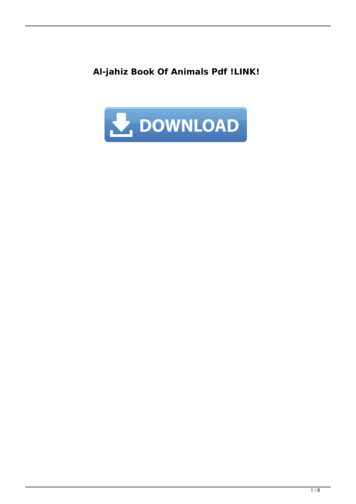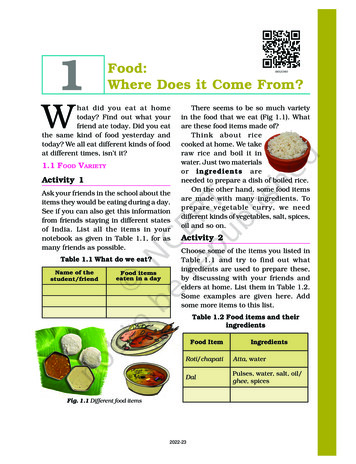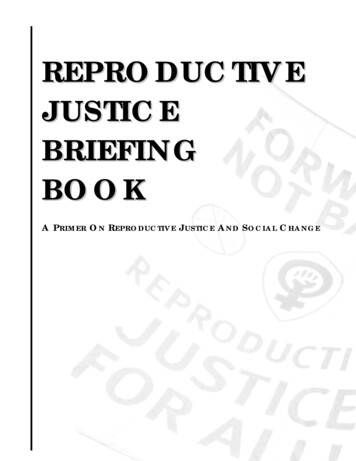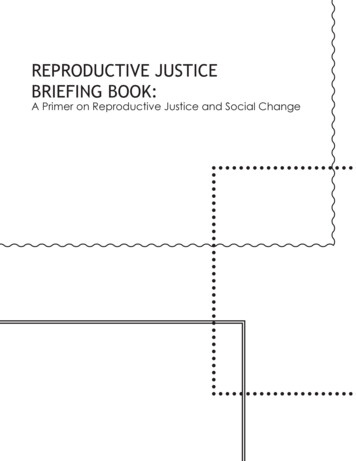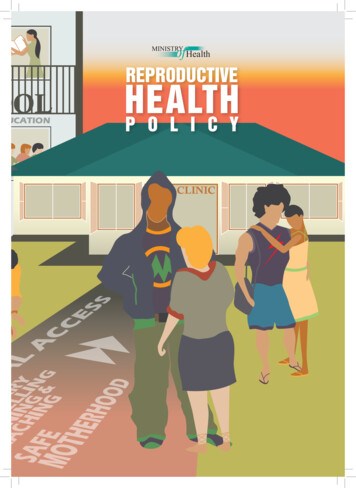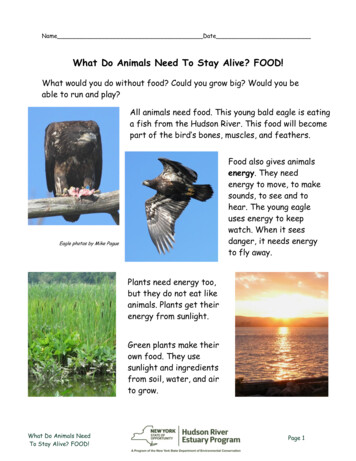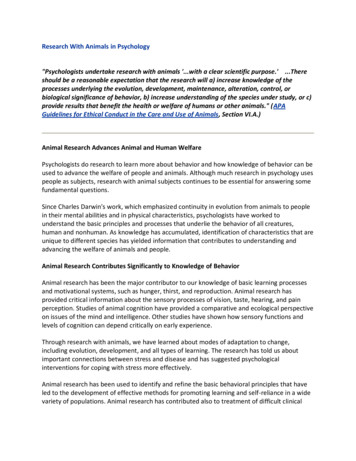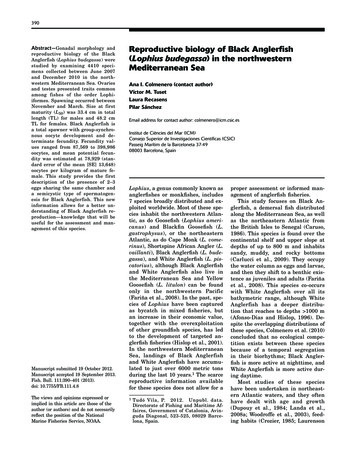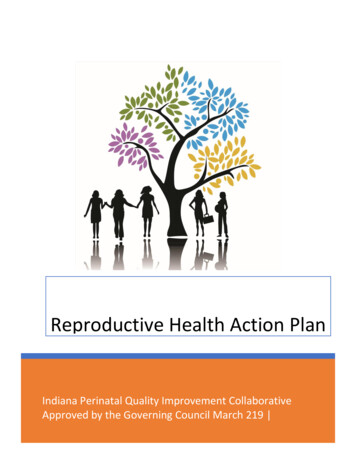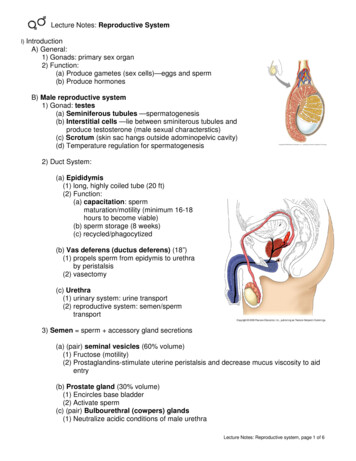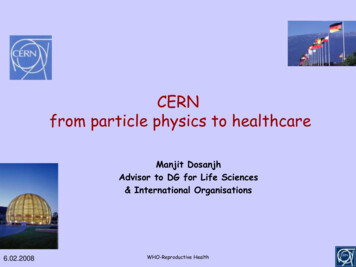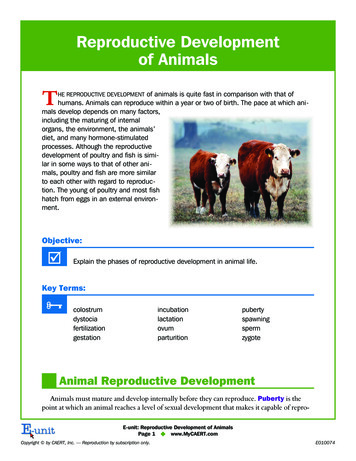
Transcription
Reproductive Developmentof AnimalsTHE REPRODUCTIVE DEVELOPMENT of animals is quite fast in comparison with that ofhumans. Animals can reproduce within a year or two of birth. The pace at which animals develop depends on many factors,including the maturing of internalorgans, the environment, the animals’diet, and many hormone-stimulatedprocesses. Although the reproductivedevelopment of poultry and fish is similar in some ways to that of other animals, poultry and fish are more similarto each other with regard to reproduction. The young of poultry and most fishhatch from eggs in an external environment.Objective:þExplain the phases of reproductive development in animal life.Key mzygoteAnimal Reproductive DevelopmentAnimals must mature and develop internally before they can reproduce. Puberty is thepoint at which an animal reaches a level of sexual development that makes it capable of reproE-unit: Reproductive Development of AnimalsPage 1 u www.MyCAERT.comCopyright by CAERT, Inc. — Reproduction by subscription only.E010074
duction. In a female the estrous cycle begins, and she will experience her first estrus. In a malethe testicles develop, and he will produce his first ejaculate with some fertile sperm.Puberty is not the point of complete reproductive development. Animal fertility is actuallyquite low, and chances of achieving pregnancy are very slim. In the female the uterine body isnot prepared to accept the attachment of an embryo. The male does not produce a highenough level of sperm cells to service females continually. He can even become sterile for atime if not let develop fully before being used for regular breeding.Male and female animals develop reproductively at different rates. For example, a young giltwill usually experience her first estrus at 6 to 8 months of age. A young boar will typicallyreach puberty at 5 to 18 months of age. It is important to remember that pigs and other animals’ reproductive development is influenced by many factors. These include their environment, nutrition, breed, exposure to mature animals, and health.Animal producers must be cautious when mixing sexes of animals approaching puberty.While the chances of a fertile mating occurring are slim, unwanted pregnancies are possible.Once animals fully develop reproductively, they are then mated to produce newoffspring. For a mating to be successful, fertilization must occur. Fertilization is theuniting of the ovum of the female and thesperm of the male. The ovum is the femalesex cell. The sperm is the male sex cell.Semen containing sperm is deposited in thefemale. Usually the male must mount thefemale, insert his penis into her reproductiveSpermtract, and deposit the semen. The sperm cellsin the semen then use a swimming-likemotion to find the ovum. When a sperm cellEggpenetrates the ovum, fertilization occurs.Once the ovum becomes fertilized, it is called FIGURE 1. Fertilization occurs when the sperm of the malea zygote, or fertilized sex cell. When united, unites with the egg of the female.the two sex cells exchange DNA, and ifeverything goes correctly, a pregnancy willoccur.The zygote will travel down through the female reproductive tract and eventually attach tothe uterine wall. At this point, gestation begins. Gestation is the period during which the offspring grows and develops in the uterine body of its mother. The young grows from the diameter of pencil lead to birth weight. Birth weight is normally reflective of the mature size of theanimal. For example, the birth weight of an elephant is significantly higher than that of a housecat.The length of gestation varies with the species. It can be quite long—for example, approximately 340 days for horses. A dog’s gestation is about 56 days. A rabbit’s is fairly short—approximately 31 days.E-unit: Reproductive Development of AnimalsPage 2 u www.MyCAERT.comCopyright by CAERT, Inc. — Reproduction by subscription only.E010074
Near the end of gestation, the mother prepares to give birth. The process of giving birth iscalled parturition. Parturition involves several steps. The cervix dilates; the uterine bodybegins contracting; the offspring is expelled from the body; and the placenta, or afterbirth, isexpelled. This can take anywhere from 1 to 12 hours.Animals approaching parturition should be carefully monitored. Problems, such as dystocia,can occur. Dystocia is severe distress in the female while giving birth. Assistance may beneeded to complete the process. A professional, such as a veterinarian, should be consulted.A female typically gives signs of approaching parturition. These could include the buildingof a nestlike-structure, isolation from other animals, or a noticeable change in behavior.Shortly before or immediately after parturition, the female prepares to care for her young.This is done through the production of milk, or lactation. This is extremely important forthe survival of the young. The first milk, or colostrum, provides enzymes to fight bacteriaand disease. A young animal is commonly exposed to a harsh environment at birth and needsall the defense it can get to remain healthy and strong. The milk is extracted from the mother’smammary system. Lactation, like parturition, is stimulated by hormones in the body of thefemale. Hormones are released to begin both processes at nearly the same time.POULTRY AND FISH REPRODUCTIVE DEVELOPMENTThe reproductive development of poultry and fish is very similar. Poultry and most fishhatch their young from eggs in an external environment from the body. Like animals, theymust reach sexual maturity before they are able to reproduce.PoultryIn poultry the female begins producing eggs in her body on a regular basis. Fertilizationoccurs within her body. The male mounts the hen and deposits sperm into her funnel. Thesperm cells are included in theegg as it develops and passesthrough the funnel.The female will then start laying eggs in a nest. The quality,type, and size of the nest dependon the species of the poultry.Once the desired number of eggsis laid, incubation begins. Incubation is the act of poultry physically sitting on top of the eggs tokeep them warm until the younghatch. The temperature must bekept in a range of 99 to 100 F(37.2 to 37.8 C). The poultryFIGURE 2. This goose nest is built of twigs and feathers to protect the eggs.will incubate the eggs for the(Courtesy, USDA)E-unit: Reproductive Development of AnimalsPage 3 u www.MyCAERT.comCopyright by CAERT, Inc. — Reproduction by subscription only.E010074
required number of days, which varies among species. The incubation period for a chicken is21 days, a turkey 28 days, and an ostrich more than 40 days.The poultry must also maintain the humidity of the eggs for the last two weeks of nesting.This will soften the eggs and assist the young when hatching. The eggs must also be exposed tosufficient levels of oxygen and turned 2 to 5 times daily for the first 14 to 18 days of nesting. Ifthe eggs are properly fertilized, cared for, and not found by predators, young should hatch.FishFish also build nestlike structures in which to lay their eggs. They build them in the mudand rock along or near the banks of rivers and lakes. Fish are seasonal breeders, stimulated bydaylight, water temperature, and other environmental factors.Spawning is the act of the female fish laying thousands of eggs in a nest, where they arefertilized by the male fish. The male and female fish will guard the nest until their younghatch. Incubation of the eggs takes 6 to 10 days, depending on the temperature of the water.The warmer the water, the faster the eggs hatch.Summary:2Animals must mature and develop before they can reproduce efficiently. This process begins with the animals going through puberty so that sex cells can be produced by both sexes. Once the animals are developed reproductively, fertilizationmust occur by uniting a sperm cell and an ovum. Once pregnant, the female beginsthe gestation process. At the conclusion of gestation, parturition begins. During orshortly after the birthing process, the female begins lactating to support her young.Poultry must also mate before an egg can be fertilized. The fertile eggs are laid in anest and incubated until they hatch. Fish, too, lay their eggs in a nest. Once thefemale lays the eggs, the male fertilizes them.Checking Your Knowledge: 1. Why is fertility still low after puberty?2. What should an animal producer do in cases of dystocia during parturition?3. Why is it important for a young animal to obtain colostrum?4. Why must poultry maintain the humidity of their eggs?5. How does the fertilization of poultry and fish eggs differ?E-unit: Reproductive Development of AnimalsPage 4 u www.MyCAERT.comCopyright by CAERT, Inc. — Reproduction by subscription only.E010074
Expanding Your Knowledge:LInterview an animal producer to discuss the processes of breeding, fertilization, andparturition. Ask questions about when fertilization occurs in animals of the producer’s specialty. Also, ask about special care of females during their gestation process. Do the animals have special needs? Ask about steps to prepare for parturitionof females. Are any special procedures necessary? What does the producer do ifdystocia occurs? Ask to participate in the breeding, fertilization, or parturition process of an animal. Share the results of this interview with your classmates.Web Links::Gestation Table for nine Breeding and 52/Chicken Embryo Developmenthttp://www.rit.edu/ nlwsbi/EMBRYOS.HTMAgricultural Career it: Reproductive Development of AnimalsPage 5 u www.MyCAERT.comCopyright by CAERT, Inc. — Reproduction by subscription only.E010074
tract, and deposit the semen. The sperm cells in the semen then use a swimming-like motion to find the ovum. When a sperm cell penetrates the ovum, fertilization occurs. Once the ovum becomes fertilized, it is called a zygote, or fertilized sex cell. When united, the two sex cells exchange DNA, and if everything goes correctly, a pregnancy will .
